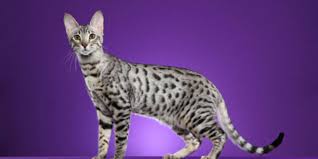
Serengeti
Conditions of detention
Serengetis thrive in environments where they have plenty of space to explore and play. They enjoy having access to interactive toys, climbing structures, and activities that engage their natural curiosity and agility.
Useful Fact:
Serengetis are known for their energetic and playful nature. They require regular stimulation and exercise, making them well-suited for active households that can provide them with attention and engagement.
Nutrition and diet
Serengeti cats thrive on a diet rich in high-quality protein, similar to what their wildcat ancestors consume. This can be provided through premium commercial cat food supplemented with occasional treats for variety and enrichment. Their diet should support their active lifestyle and muscle maintenance.
Useful Fact: Due to their energetic nature, Serengeti cats may benefit from diets formulated to meet the needs of active breeds, ensuring they receive adequate nutrition for their vitality.
Health
Serengeti cats are generally robust and healthy with no specific breed-related health issues. Regular veterinary check-ups are essential to monitor their overall health, dental hygiene, and vaccination schedules.
Useful Fact: Maintaining a healthy weight is crucial for Serengeti cats to prevent obesity, which can lead to joint problems and other health issues common in overweight cats.
Grooming and care
Serengeti cats have short, dense coats that require minimal grooming compared to long-haired breeds. Weekly brushing helps to remove loose hair and distribute natural oils, keeping their coat healthy and shiny.
Useful Fact: Their grooming routine is straightforward, making them relatively low-maintenance in terms of coat care.
Education and training
Serengeti cats are intelligent and enjoy mental stimulation. They can be trained using positive reinforcement techniques such as treats and praise. Teaching them basic commands and providing interactive toys can keep their minds engaged.
Useful Fact: Incorporating puzzle feeders and interactive toys not only enriches their environment but also satisfies their natural curiosity and intelligence.
Toys and entertainment
Known for their agility and hunting instincts, Serengeti cats thrive on interactive toys that mimic prey movements. Feather wands, puzzle feeders, and climbing structures provide physical exercise and mental stimulation.
Useful Fact: Providing a variety of toys and play opportunities helps prevent boredom and encourages healthy behavior.
Safety
Creating a safe environment for Serengeti cats involves securing windows and balconies, as they are agile climbers. Keeping toxic substances out of reach and providing stable scratching posts and perches are essential.
Useful Fact: Their curiosity may lead them to explore high places, so ensuring their safety in elevated areas is important.
Accessories
Serengeti cats appreciate comfortable bedding, sturdy scratching posts, and interactive toys that challenge their agility. Access to elevated perches allows them to observe their surroundings.
Useful Fact: Investing in durable accessories and providing varied play opportunities enhances their well-being and prevents furniture damage.
Socialization
Serengeti cats are social and form strong bonds with their human companions. Early socialization helps them develop into confident and friendly cats that get along well with children and other pets.
Useful Fact: Regular interaction and positive experiences with different people and environments contribute to their well-rounded personality.
Travel and Transportation
Serengeti cats can adapt to travel if introduced gradually and provided with a secure carrier. Familiarizing them with the carrier and taking short practice trips can help reduce travel stress.
Useful Fact: Ensuring they have familiar items such as bedding or toys in the carrier can provide comfort during journeys.
Behavior and psychology
Serengeti cats are affectionate and playful, enjoying interactive play sessions with their owners. They thrive on attention and are known for seeking out companionship within their family.
Useful Fact: Providing regular mental stimulation through play and enrichment activities supports their natural behaviors and strengthens the bond with their owners.
Legal aspects
Owning a Serengeti cat involves complying with local regulations regarding pet ownership, licensing, and identification. Ensuring they are up to date with vaccinations and microchipped is important for their health and legal compliance.
Useful Fact: Researching local laws and obtaining necessary permits ensures responsible pet ownership and compliance with regional requirements.


